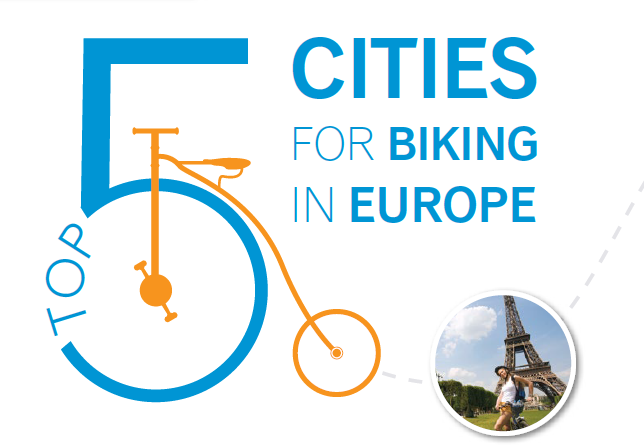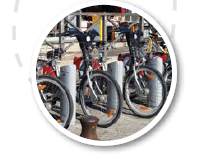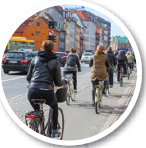 Europeans love bicycles—many cycle to work daily, wearing suits, dresses, even high heels, weaving through cobblestone streets at a leisurely pace. Cycling is an essential part of European culture, and a great way to sightsee without the hassle or pollution of a motor vehicle. That’s why a number of European cities are making strides to encourage even more cycling, in order to decrease their carbon footprint and promote healthy lifestyles. To get a glimpse of just how rapidly European bike transit systems are evolving, here are a few of our favorite cities that are embracing the European bike movement.
Europeans love bicycles—many cycle to work daily, wearing suits, dresses, even high heels, weaving through cobblestone streets at a leisurely pace. Cycling is an essential part of European culture, and a great way to sightsee without the hassle or pollution of a motor vehicle. That’s why a number of European cities are making strides to encourage even more cycling, in order to decrease their carbon footprint and promote healthy lifestyles. To get a glimpse of just how rapidly European bike transit systems are evolving, here are a few of our favorite cities that are embracing the European bike movement.
#5 Paris, France
Paris might be a big, bustling city full of fast cars and cro wded streets, but its bike rental system is rapidly developing. Founded in 2007, the Vélib’ bike loan system is one of the largest in the world, with about 20,000 bicycles available at about 1,600 docking stations across the urban area. That’s more than one every mile! While the streets are still a little tough to maneuver, Paris’s public parks and gardens are perfect spots for biking. There are paths along the elevated railway-turned-park of the Coulée verte René-Dumont (or Promenade plantée), across the Champ de Mars, or through the vast Bois de Boulogne park. In the next few years, the biking atmosphere will continue to improve with low 30 kph speed zones and the removal of archaic expressways along the River Seine.
#4 Barcelona, Spain
 Barcelona might not be entirely bike-friendly yet, but it certainly has plenty of beautiful spots to bike, from city to beach to hill. The main attractions of Barcelona, like the Sagrada Família, Las Ramblas, and Montjuïc, are just close enough to hop from site to site by bike. And there’s no better way to see Barceloneta, the city’s mile-long urban beach, than to ride leisurely across its boardwalk. Today, 4% of Barcelona commuters cycle on a daily basis, and bikes are available throughout the city through the Bicing rental program started in 2007. To boost enthusiasm for cycling even more, the city of Barcelona established an annual “Bike Week” each May, which involves group bike rides, bike expos, and a used bike market.
Barcelona might not be entirely bike-friendly yet, but it certainly has plenty of beautiful spots to bike, from city to beach to hill. The main attractions of Barcelona, like the Sagrada Família, Las Ramblas, and Montjuïc, are just close enough to hop from site to site by bike. And there’s no better way to see Barceloneta, the city’s mile-long urban beach, than to ride leisurely across its boardwalk. Today, 4% of Barcelona commuters cycle on a daily basis, and bikes are available throughout the city through the Bicing rental program started in 2007. To boost enthusiasm for cycling even more, the city of Barcelona established an annual “Bike Week” each May, which involves group bike rides, bike expos, and a used bike market.
#3 Seville, Spain
When it comes to European biking spots, Seville is the loveable under dog. Full of crowded streets and medieval remnants, Seville wasn’t a city that anyone thought could change. After all, it has four rush hours a day, thanks to the Spanish siesta schedule. And with its hot weather, biking to work didn’t seem like a pleasant option. But some very tenacious city leaders saw the potential for a greener Seville in 2006. Within a year, 50 miles of bike lanes were created, and shortly afterward the city’s bike rental program, Sevici, was established. A modern transportation miracle, Seville went from .5% to 7% of commutes by bike within 6 years.
dog. Full of crowded streets and medieval remnants, Seville wasn’t a city that anyone thought could change. After all, it has four rush hours a day, thanks to the Spanish siesta schedule. And with its hot weather, biking to work didn’t seem like a pleasant option. But some very tenacious city leaders saw the potential for a greener Seville in 2006. Within a year, 50 miles of bike lanes were created, and shortly afterward the city’s bike rental program, Sevici, was established. A modern transportation miracle, Seville went from .5% to 7% of commutes by bike within 6 years.
#2 Amsterdam
Amsterdam has been at the top of the charts for decades. The small, compact city’s flat terrain, narrow streets, and low speed limit make it a biker’s paradise. The city has 248 miles of bike lanes, and 32% of all trips made within the city are made by bike. In fact, there are more bikes than people! With a population of 779,808, Amsterdam has 880,000 bikes within its limits. Locals leisurely wind through alleys and around shops at all hours of the day. There’s only one problem: parking. With so many bikes, cyclists have to get creative, locking their vehicles to trees, lamp posts, fences, bridges. Thousands end up in Amsterdam’s famous canals each year. To counteract this issue, bike parking garages have been placed all over the city, including the famous Amsterdam Centraal Station bike ramp which holds over 7,000 bikes. Even though Amsterdam is miles ahead of most countries in the bike department, the city has recently increased its bike-friendliness with lower speed limits for cars, more bike lanes, bike-specific traffic signals, and of course, more bike parking garages.
#1 Copenhagen
Dubbed the “City of Bikes,” Copenhagen has one of the most distinct bike cultures around the world. Voted the European Green Capital in 2014, Copenhagen aims to be CO2-neutral by 2025, and the first step of this was to convert over 50% of the city’s transportation to cycling. Now over half of daily commutes within Copenhagen are made by bike, and over 200 miles of bike lanes cover the 34-square-mile city. Beyond the sheer quantity of bikes  (650,000 for a 569,557 population), the safety standards of the city make it like Disneyland for cyclists: bike paths stretch 10 feet wide and are separated from cars with partitions, so there’s plenty of space to pass and turn without needing to dodge cars. The city even offers bicycles that you can rent for free with a refunded coin deposit, located at public bike share stations around the area. The only downside: bicycle rush hour, when more than 35,000 cyclists cross the bridge each day. Copenhagen’s biking philosophy is so strong and effective that various organizations share the city’s methods with other countries around the world, including the company Copenhagenize and the official Cycling Embassy of Denmark.
(650,000 for a 569,557 population), the safety standards of the city make it like Disneyland for cyclists: bike paths stretch 10 feet wide and are separated from cars with partitions, so there’s plenty of space to pass and turn without needing to dodge cars. The city even offers bicycles that you can rent for free with a refunded coin deposit, located at public bike share stations around the area. The only downside: bicycle rush hour, when more than 35,000 cyclists cross the bridge each day. Copenhagen’s biking philosophy is so strong and effective that various organizations share the city’s methods with other countries around the world, including the company Copenhagenize and the official Cycling Embassy of Denmark.
Ready to explore Europe? Our European Highlights tour will get you on your way!
